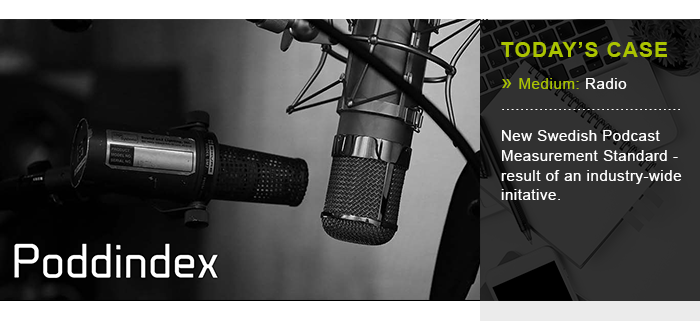| Click here to view this e-mail in your browser |
|
|||
| Business case studies | No 196 - 24.11.2017 |
 |
Sweden introduces podcast measurement standards Podcast and on demand audio are a hot topic in the audio space and many publishers are developing their strategies to expand this category within their offer. One of the barriers is a lack of proper measurement tools and standards, recognised by publishers and advertisers. An industry-wide initiative in Sweden came up with a solution and developed the Swedish Podcast Measurement Standard – Poddindex. It went live in November 2017. Background These standards are the result of cooperation among the major players on the Swedish audio market: Sveriges Radio (public broadcaster), Acast (platform for podcast hosting, distribution and monetisation), Bauer Media and MTG Radio (private broadcasters). The standardised methodology is implemented by the group's members and audited by the third-party organisation Sveriges Annonsörer (The association of Swedish advertisers). The purpose of this standardisation is to introduce transparent and consistent podcast audience metrics across podcasts, publishers, platforms and service providers. The standardisation offers all podcast stakeholders a defined set of metrics making it possible to track listening consistently over time and to equally compare podcasts and podcast networks, minimise risk of fraud and non-human traffic measurement. Mattias Björkman, Digital Business Development Manager at Bauer Media commented: “Podcast and on-demand audio are growing rapidly, but are lacking transparent and consistent metrics. As a radio broadcaster we know that strong currencies are vital for commercial growth and although IAB initiatives are making progress in podcasting, we had the opportunity to take a first step in Sweden. We saw uncertainty and confusion among advertisers and decided that it would be beneficial if we could agree on one single set of metrics and methodology. It was far more challenging to achieve than we first realised and it took us two years of discussions and compromises to agree on this set of metrics, filters and values. The main reason behind success is that we focused on agreeing rather than finding the ultimate solution. Another success factor is that each group member and expert had a mandate to actually achieve change within their own organisations. That’s probably more difficult to achieve in greater markets with 10+ players but I hope that our initiative in Sweden can prove to be the first step towards a global standardisation. Podcasting is still young and much will happen during the next few years.” Swedish Podcast Audience For the purpose of these standards, podcast is defined as all editorial audio content that can be consumed on demand, including audio productions that were broadcast on radio as well as productions exclusively distributed on demand. Swedish podcast listening has grown by 36% during the last two years and now amounts to 1.6 million listeners weekly (20%) and 3.3 million monthly (40%). Podcasts are accessed through a wide range of applications, websites and devices, in this context called clients. Apple iTunes-podcaster is the biggest client, listening is however fragmented across the proprietary publisher platforms such as Sveriges Radio Play (SR), Acast (Acast), RadioPlay (Bauer Media) and I Like Radio (MTG). Server-Side Measurement The measurement technology measures both the audience and the ad serving through servers streaming the content rather than clients consuming it. The methodology includes two metrics (reach and listens). Measurement of time consumed is not yet included in this methodology. The main reason being that server-side measurement poses different challenges in standardising the measurement of time, for example how to estimate time spent on downloaded episodes for time-shifted listening. Measurement of Reach Reach is an estimate of the number of unique listeners during a given time on a given podcast or a given set of podcasts. While the metric aims to capture unique individuals it is, with the exception of User ID, limited to unique clients. Unique identification through User ID, Device ID, and Cookie ID is similar to most digital client-side measurements. Measurement of Listens A listen is a started or downloaded podcast, it is not based only on the raw number of requests to the server since there is always a risk that the request is done by non-human traffic or by clients creating several requests for one single listener and play. The methodology addressed this by creating several filters making sure traffic is as human as possible. (Examples of filters for duration and frequency: a listen should only be counted when the listener has listened to the podcast for at least 10 seconds, only include requests if the range starts at 0 or making sure only one single request per session is counted, a listen should only be counted when the entire file is downloaded, the number of requests per file is limited to 10 listens per unique identifier and hour.) Measurement of Ad Delivery The methodology for podcast audience measurement also applies to podcast audio advertising with some differences. Ads integrated in the content are measured through the same audience metrics. Ads dynamically inserted in the content are delivered either by the server or the client stitching ads to the requested file. Usually the main metric for dynamic ad delivery and for CPM pricing are impressions. They are similar to listens, but have somewhat different attributes, mainly because several impressions can be delivered in one listen (e.g. one pre-roll and mid-roll). To achieve accuracy the impression tracking should include duration filters as well as frequency filters discussed above. Details and values in such filtering can however differ due to ad duration, capping and frequency rules set by the publisher. Just as with other digital advertising it is recommended considering third party ad tracking. |
|
| egta - 22, Rue des Comédiens, boîte 4 - 1000 Brussels - T: + 32 2 290 31 31 - www.egta.com |






